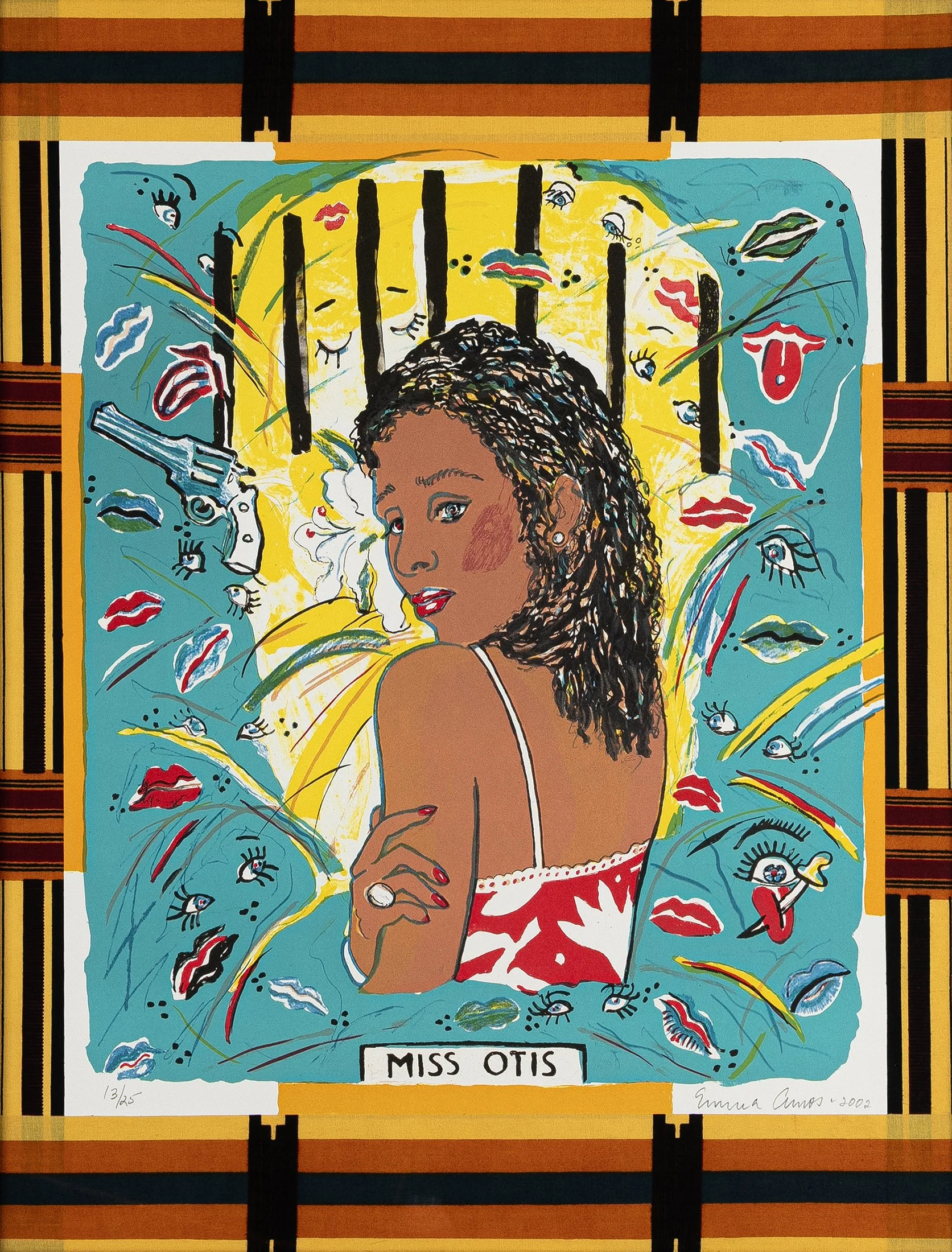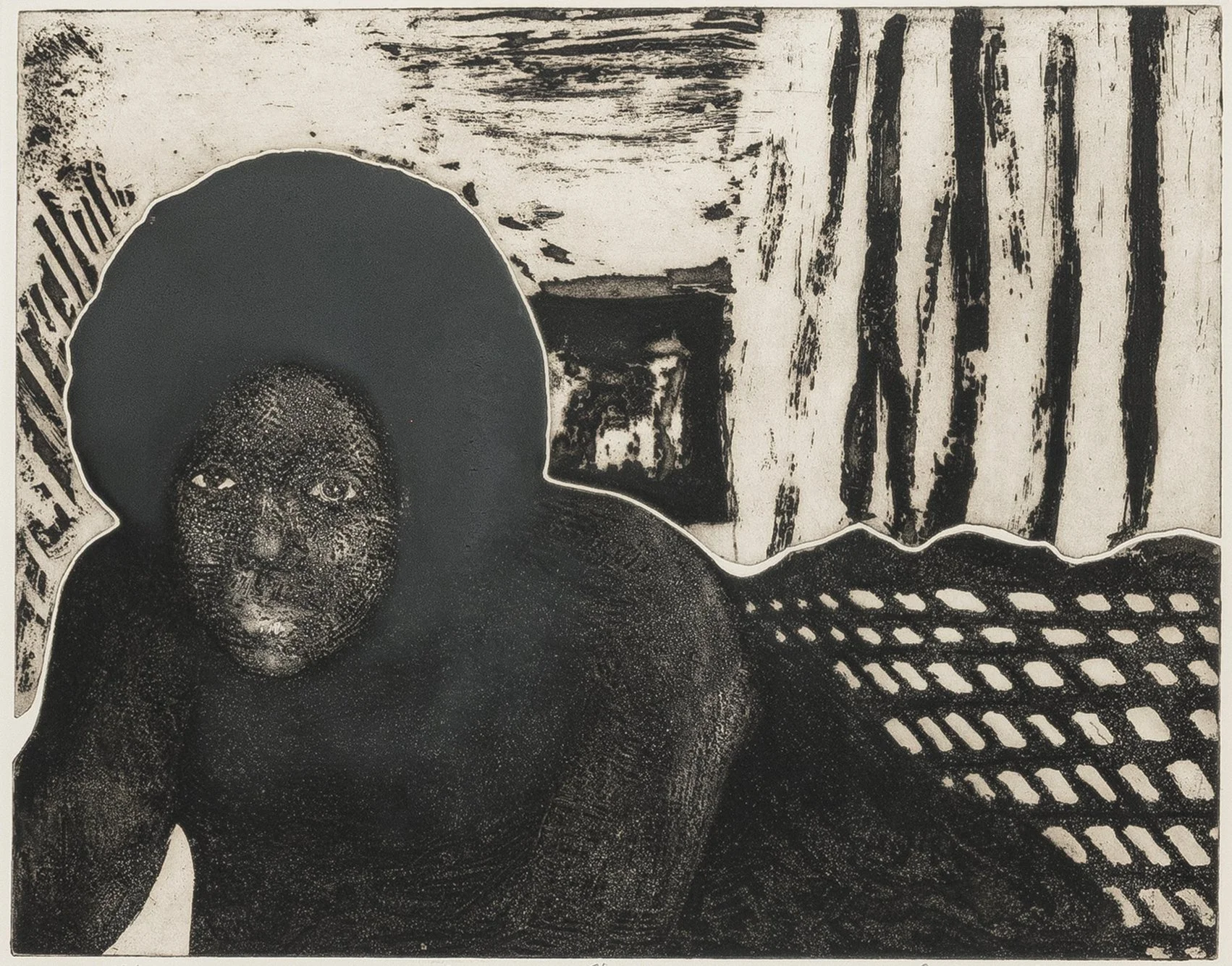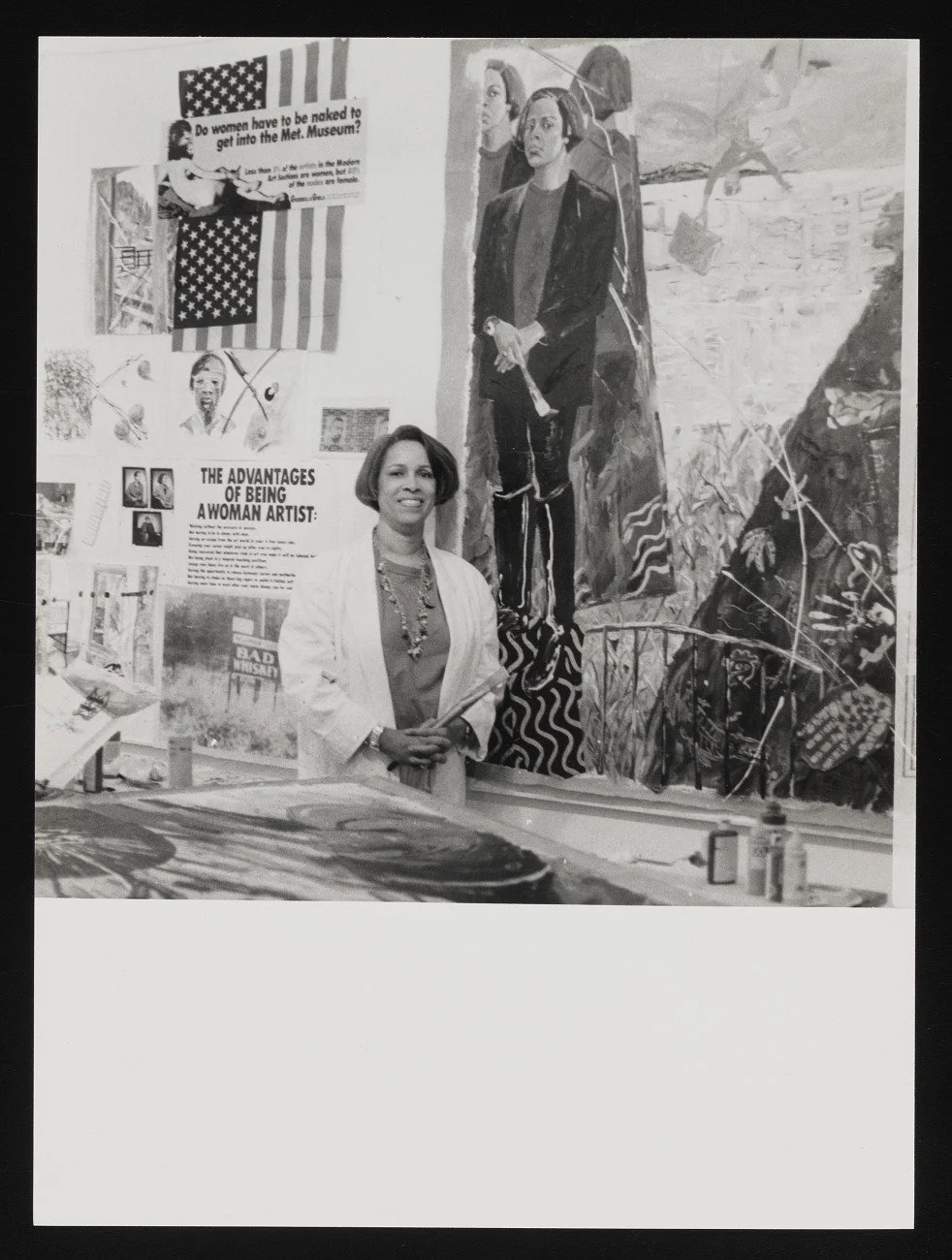
Emma
Amos
(1937-2020)
American Girl
1974
etching and aquatint
15-5/8 x 19-3/4 inches
signed, dated, titled and numbered 19/35
“American Girl is part of a portfolio called “Impressions: Our World, Vol. 1,” which makes a statement in itself. Made up of prints by seven black artists, both men and women, it was produced at the Printmaking Workshop, run by the African-American artist Robert Blackburn. It was significant that a group of black artists arranged the project themselves. Many at the time had protested museums’ failures to include the work of African-Americans, and black artists were seeking “a voice in defining the context in which [their] work [was] shown,” says Evelyn Hankins, senior curator at the Smithsonian’s Hirshhorn Museum and Sculpture Garden. All the prints in the portfolio are in black and white, the same color scheme that Spiral had chosen, because of its racial connotation, for the group’s exhibition in the 1960s.”
Photos: Emma Amos papers, circa 1900-2019. Archives of American Art, Smithsonian Institution.

Emma Amos (b. 1937, Atlanta) was raised in a well-educated, well-connected family whose social circle was said to include figures such as Booker T. Washington and Zora Neale Hurston. At sixteen, she left Atlanta for Antioch College in Ohio, earning a B.A. in Fine Art. During her studies, she spent time in London and received a diploma in etching from the Central School of Art. After returning to the U.S. in 1960, she worked for the pioneering textile designer Dorothy Liebes (1961–72). At the same time, she completed an M.F.A. in Art Education at NYU, studying lithography with Robert Blackburn. She was invited to join the Spiral collective—alongside Romare Bearden, Charles Alston, and Norman Lewis, becoming its first and only female member. Originally committed to abstraction, she increasingly brought figuration into her work as the civil rights movement gathered momentum.
After the birth of her daughter, Amos focused on quilting, illustration, and weaving, and co-hosted WGBH Boston’s craft how-to program “Show of Hands.” In the late 1970s she returned to painting. Her mature style combined saturated color and dynamic subjects with her own weavings and vibrant African textiles. Athletic bodies running, dancing, and diving recur throughout this period; by the late 1980s, figures appear to fall or fly. Following a 1979 solo at the Art Salon, she began teaching at Rutgers’ Mason Gross School of the Arts (NJ), eventually becoming a full professor and chair of the art department.
Amos was unflinching in her engagement with race, gender, and politics. In later works she appropriated and reexamined canonical imagery, especially that of Picasso and Gauguin, exposing the racist and sexist currents within art history, and often inserting herself directly into the scenes.
“She would picture herself countering the obstacles of the art world or challenging well-known artists that she may have admired, but then she began to take a second look at what they were actually communicating about women, power.”
—Shawnya L. Harris, curator of Emma Amos: Color Odyssey, Georgia Museum of Art, 2021
Beyond the studio, Amos served as an editor of Heresies: A Feminist Publication on Art and Politics and was a member of the confrontational Guerrilla Girls, an affiliation not confirmed until after her death. The anonymous collective, known for gorilla masks and pseudonyms drawn from women artists of the past, spotlighted the underrepresentation of women in museum exhibitions and gallery rosters through pointed, public interventions.
Ref: Duron, Maximiliano. “How Emma Amos’s Art and Activism Powerfully Confronted Racism and Sexism.” ARTnews.Com, ARTnews.com, 30 Apr. 2021, www.artnews.com/feature/emma-amos-who-is-she-why-is-she-important-1234591424/.
Miss Otis
2002
colored lithograph with collage elements
26 x 20-1/2 inches
signed, dated, and numbered 13/25

Selected Exhibitions
Emma Amos: Paintings & Prints: 1982–1992; College of Wooster Art Museum, OH (1993); traveled to Studio Museum in Harlem, NY; Hammonds House, Atlanta; Bruce R. Watkins Cultural Heritage Center, Kansas City; Southern Ohio Museum, Portsmouth (1993–95)
Spiral: Perspectives on an African-American Art Collective; The Studio Museum in Harlem, NY (Jul 14–Oct 23, 2011).
Witness: Art and Civil Rights in the Sixties; Brooklyn Museum, NY (Mar–Jul 2014); traveled to Hood Museum and Blanton Museum (2014–15).
We Wanted a Revolution: Black Radical Women, 1965–85; Brooklyn Museum, NY (Apr 21–Sep 17, 2017); traveled to ICA Boston and CAAM.
Emma Amos: Black Bodies; RYAN LEE Gallery, New York (Oct 19–Dec 23, 2017). Critically noted late-career solo
Soul of a Nation: Art in the Age of Black Power; Tate Modern, London (2017); U.S. tour incl. Crystal Bridges, Brooklyn Museum, The Broad, MFA Houston (2018–20)
Emma Amos: Color Odyssey; Georgia Museum of Art, Athens, GA (Jan 30–Apr 25, 2021); traveled to Munson Museum of Art, Utica, NY (Jun 19–Sep 12, 2021) and Philadelphia Museum of Art (Oct 11, 2021–Jan 2, 2022). Major career retrospective.
“Amos’s artistic concerns have centered on the politics of gender, race, sexism, and ethnocentrism. Her works across the media demonstrate the activist role that imagery can play. Her longtime interest in textile manifests itself through the cloth she incorporates into many of her paintings and prints. Her boundary-breaking approach to materials gives little regard to the arbitrary high/low art divide that separates textile arts from painting.”

